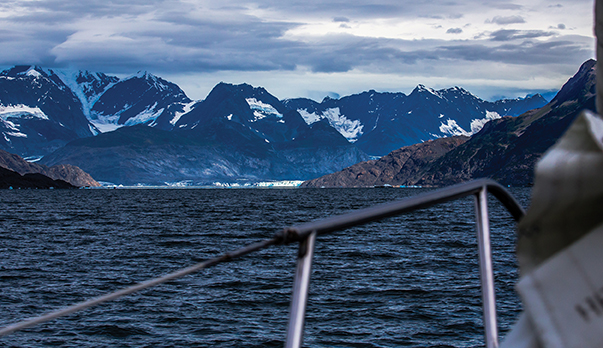Previously published in BWS by Ellen Massey Leonard.
You’ll check over your rig, your steering, your engine, your systems, your electronics, and your ground tackle to make sure everything is in good working order; you’ll overhaul your safety gear and maybe add some equipment, such as survival suits; and if you don’t have a heater you’ll install one. All that is the essential part. But if you’d like to make your cold weather sailing comfortable as well as safe, here are ten items that will go a long way to keep up crew morale.
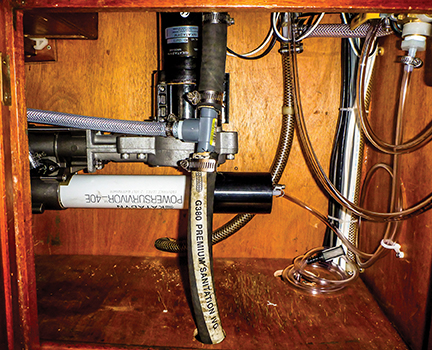
Katadyn desalinator
1. A DESALINATOR For years I was a proudly primitive sailor who hefted buckets of water from shore to dinghy to boat, and who took saltwater showers. Since 2014, I’ve been a watermaker convert. I have a Katadyn 40E PowerSurvivor (now sold by Spectra) that produces one and a half gallons per hour at four amps. It’s great: I wash my pots and pans in fresh water and they don’t corrode; I take (short) fresh water showers and I don’t have to fill my tanks with water from shore if it’s at all questionable. Plus, I can run the desalinator off my solar panels. Obviously this is a ‘great to have’ item for any latitude, but there are two reasons that it’s especially nice for cold weather sailing.
First, it can be difficult if not impossible to fill from shore in the high latitudes. The Arctic is a desert without much drinking water to begin with. So water there can be expensive if you can even obtain it at all. Plus, it might be difficult to bring it to the boat. For example, there are no ports north of Nome, Alaska and north of the Bering Strait it’s only exposed coastline with surf breaking on the beaches. Getting ashore requires patience. On my recent voyage up there, I also had to anchor a few miles from the nearest village on several occasions. I was very happy not to have to heft jerry jugs then! Instead, I spent seven enjoyable weeks without filling from shore and without rationing. In sub-Arctic latitudes, it can also be a challenge to fill from shore, either because you’re far from civilization or because the ports are built for commercial and fishing traffic so that the docks are high piling piers, not ideal for a sailboat.
Second, you won’t be doing much swimming during your cold-weather cruise, nor will you particularly want to take a bucket shower on deck. So it’s really nice to be able to make fresh water to bathe in. It doesn’t have to be much—I often just heat up a kettle for a sponge bath—but it makes a big difference in morale.
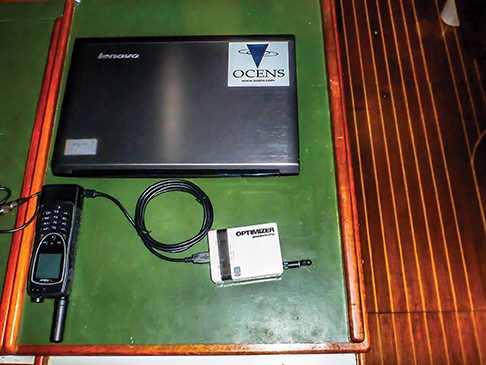
Sat phone and router connected to the laptop
2. SATELLITE COMMUNICATIONS If you’re venturing to the Arctic, where HF signals are weak, an Iridium set-up (other providers have spotty coverage up there) might be your only option for receiving weather information. On my voyage to the Alaskan Arctic, I used an Iridium Extreme phone with an external antenna and OCENS software and never had a dropped connection. This was crucial for receiving weather and ice information. In fact, I would put this in the ‘essential for safety’ category for anyone venturing to the Arctic.
Outside these extreme latitudes, satellite communications fall more into the ‘great to have’ category. I find the ease and speed with which a satellite connection downloads GRIBs and emails a real luxury after having spent years fiddling with my SSB. Plus, it’s nice to know I can actually call or text those at home from anywhere. This gives real peace of mind in any situation, but especially if you’re heading to cold climes. And don’t forget the peace of mind this gives to those left on shore!
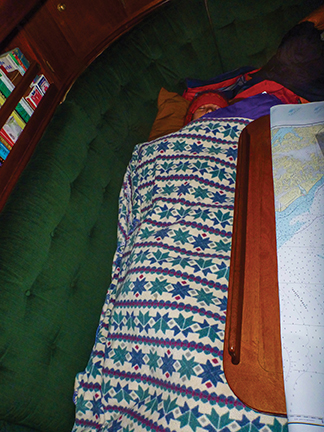
Tucked into the sleeping bag in the gulf of Alaska
3. A SLEEPING BAG If you’re used to sleeping in sheets and blankets on your cruises, you might overlook this wonderfully cozy item. Unless you have unlimited fuel, your cabin will still feel cool even with a heater running. I love my sleeping bag: I warm up quickly when my watch is over and thus fall asleep a lot faster. I use a sleeping bag liner so that I only have to launder that instead of the whole bag. The only downside is that you won’t want to get out of it for your watch.
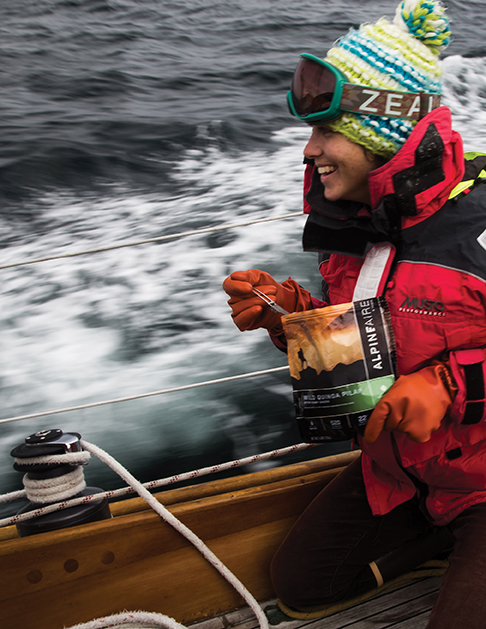
4,5 & 6 AlpineAire meal, fishermens gloves and ski goggles on a passage to the Arctic
4. ALPINEAIRE MEALS Cold weather sailing can also be rough weather sailing, and only the most iron of stomachs can cheerfully prepare coq au vin in the pitching galley. I used to eat U.S. military rations during gales but they aren’t particularly tasty, so I now eat AlpineAire meals. They’re all-natural, freeze-dried, instant meals that really do taste delicious. They were designed for backcountry hikers, but they’re equally good for a stormy night at sea. You just add boiling water to the pouch, stir it, wait ten minutes and eat it right out of the pouch. No cooking, no dishes. Wonderful for nauseated or tired watch-standers. My favorites are probably the vegetarian Mountain Chili, the Mac and Cheese (comfort food!), and the Pineapple Orange Chicken. There’s also some great gluten-free options like Wild Quinoa Pilaf.
5. FISHERMAN’S GLOVES I’ve gone through many pairs of these inexpensive orange hardware store gloves. They’re fleece-lined waterproof rubber gloves that are ideal for working on deck in cold, wet conditions. I use them for everything from pulling the anchor into the bow roller to reefing to steering. They allow enough dexterity to be easy to work in and they’re warm enough even for arctic conditions. The downside is that once the fleece on the inside gets wet, it stays damp forever more, so you’ll need a bunch of pairs on board.
6. SKI GOGGLES Protecting your eyes from sun and glare is essential, especially at sea where you’re exposed to UV rays twice as they bounce off the water. Usually this means sunglasses, preferably polarized. As the temperatures start to drop and the wind starts to howl, though, ski goggles can be really nice. They keep your face warm and keep wind, rain, and spray out of your eyes on wet days. On cold, clear days they serve the same function as sunglasses but with the added benefits of warmth and wind protection as well as completely wrapping around your face and blocking UV rays on all sides.

7. AUDIOBOOKS Sometimes standing watch keeps you very busy, but there are other times when it’s simply a matter of keeping a sharp eye on things. On those watches I like to read books, looking up from the page every few paragraphs. Rougher seas and spray can ruin your books, though, so I’ve turned more and more to audiobooks while on high latitude voyages. Once I’ve got it playing, I tuck the MP3 player inside my jacket, put in my earbuds, and I’m all set to stay awake and alert for the next four hours. An audiobook also makes a great escape when you’re feeling a little seasick or just plain tired of a long, cold passage and yearning for shore and unlimited hot showers. I’ve listened to everything from Dan Brown’s thrillers to Patrick O’Brian’s Aubrey-Maturin series to a biography of Mozart interspersed with his music.
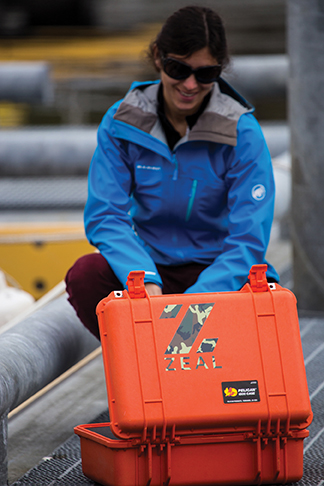
Pelican case for camera gear
8. WATERPROOF, CRUSH-PROOF PLASTIC CASES Several brands—Pelican, Nanuk, Seahorse, Crash Cases—make these incredibly sturdy cases in which you can safely keep any or all of your personal electronics. I use them for my laptop, smartphone and all my camera gear. You can cut out the foam on the inside to the shape of your device and, once the case is shut and latched, your gear will be safe from water and any kind of impact. I stow my stuff in them all the time, even in the calmest anchorage, and I feel confident bringing my cameras and computer ashore in the dinghy even in chop and rain. These are great no matter where you sail.
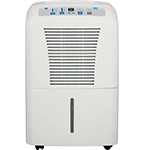
9. ACTIVE DEHUMIDIFIER You might think this is only necessary for a boat stored in the tropics, but you’d be surprised just how wet the interior of a boat can get in high latitudes, too. Mold grows fast and it’s hard to get rid of, so it’s best to prevent it before it starts. If you plan on spending much time in a marina with shore-power, or if you plan to store your boat either on the hard or in the water, it’s worth getting an active dehumidifier. I’ve left our boat for two winters in Dutch Harbor in the Aleutian Islands, Alaska, with a General Electric machine draining continuously down the galley sink drain, and my boat has been wonderfully dry and sweet-smelling upon return.
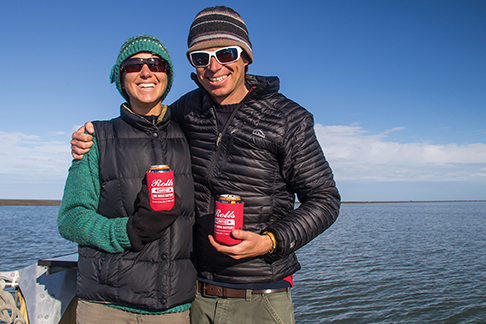
Beers to celebrate reaching Pt. Barrow, the northernmost point of the United States
10. BOOZE No, really. The more remote your cruising grounds, the more expensive everything gets. And many places in the Arctic are dry villages on account of high rates of addiction among Native peoples in the past. So if you’d like to celebrate crossing the Arctic Circle with some champagne, or even if you’d just like a beer one placid evening at anchor (I’m not advocating drinking at sea!), it’s cheaper and easier to bring it with you. And who wouldn’t want some rum when the forecast calls for freezing spray?
Ellen Massey Leonard completed a global circumnavigation at age 24 and recently sailed her classic cutter to the northernmost tip of America at Point Barrow in the Alaskan Arctic. She was honored to receive the Cruising Club of America’s 2015 Charles H. Vilas Literary Prize. She chronicles her adventures in words and photos at www.GoneFloatabout.com and on Instagram @ellenandseth.

